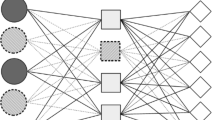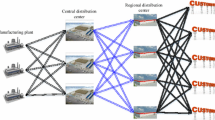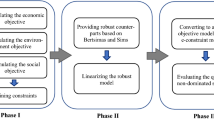Abstract
A key decision in design of a supply chain is the configuration of the network. In this study, supply chain network design problem is investigated and an efficient solution approach is presented. Specifically, a heuristic graph theoretic-based algorithm is proposed for solving a multi-echelon responsive supply chain network design problem with lateral-transshipment among retailers. The possibility of lateral-transshipment is considered to increase the customer satisfaction by increasing the availability of the goods, and to reduce total inventory handling costs. Consideration of lateral transshipment provides a trade-off between transportation costs and inventory handling costs at the retailers. Graph theory is used to investigate and study the structure of the supply chain network and it is shown that the network can be reduced to a k-partite graph. The performance of the proposed approach is compared with an exact commercial solver on test problems. The results indicate that the proposed algorithm generates high-quality solutions in a reasonable time in comparison with the exact solver.









Similar content being viewed by others
Notes
24.1.2, G., GAMS Development Corporation. Release 24.1.2.
References
Agrawal S et al (2016) Disposition decisions in reverse logistics: graph theory and matrix approach. J Clean Prod 137:93–104
Altiparmak F et al (2009) A steady-state genetic algorithm for multi-product supply chain network design. Comput Ind Eng 56:521–537
Badri H et al (2013) Integrated strategic and tactical planning in a supply chain network design with a heuristic solution method. Comput Oper Res 40:1143–1154
Chibeles-Martins N et al (2016) A multi-objective meta-heuristic approach for the design and planning of green supply chains—MBSA. Expert Syst Appl 47:71–84
Chopra S, Meindl P (2007) Supply chain management. Strategy, planning & operation, Das summa summarum des management. Springer, Berlin, pp 265–275
Coskun S et al (2016) A model proposal for green supply chain network design based on consumer segmentation. J Clean Prod 110:149–157
da Silveira Farias E et al (2017) Simple heuristic for the strategic supply chain design of large-scale networks: a Brazilian case study. Comput Ind Eng 113:746–756
Devika K et al (2014) Designing a sustainable closed-loop supply chain network based on triple bottom line approach: a comparison of metaheuristics hybridization techniques. Eur J Oper Res 235:594–615
Eskandarpour M et al (2015) Sustainable supply chain network design: an optimization-oriented review. Omega 54:11–32
Eskandarpour M et al (2017) A large neighborhood search heuristic for supply chain network design. Comput Oper Res 80:23–37
Farahani RZ et al (2014) Competitive supply chain network design: an overview of classifications, models, solution techniques and applications. Omega 45:92–118
Ghaderi H et al (2016) Biomass supply chain network design: an optimization-oriented review and analysis. Ind Crops Prod 94:972–1000
Govindan K et al (2014) Two-echelon multiple-vehicle location–routing problem with time windows for optimization of sustainable supply chain network of perishable food. Int J Prod Econ 152:9–28
Govindan K et al (2015) Bi-objective integrating sustainable order allocation and sustainable supply chain network strategic design with stochastic demand using a novel robust hybrid multi-objective metaheuristic. Comput Oper Res 62:112–130
Grahovac J, Chakravarty A (2001) Sharing and lateral transshipment of inventory in a supply chain with expensive low-demand items. Manage Sci 47:579–594
Hasani A, Khosrojerdi A (2016) Robust global supply chain network design under disruption and uncertainty considering resilience strategies: a parallel memetic algorithm for a real-life case study. Transp Res Part E Logist Transp Rev 87:20–52
Kaya O, Urek B (2016) A mixed integer nonlinear programming model and heuristic solutions for location, inventory and pricing decisions in a closed loop supply chain. Comput Oper Res 65:93–103
Klibi W et al (2010) The design of robust value-creating supply chain networks: a critical review. Eur J Oper Res 203:283–293
Krarup J, Pruzan PM (1983) The simple plant location problem: survey and synthesis. Eur J Oper Res 12:36–81
Lee YH, Kwon SG (2010) The hybrid planning algorithm for the distribution center operation using tabu search and decomposed optimization. Expert Syst Appl 37:3094–3103
Malik S et al (2015) Selection of locations of collection centers for reverse logistics using GTMA. Mater Today Proc 2:2538–2547
Mallidis I et al (2014) Design and planning for green global supply chains under periodic review replenishment policies. Transp Res Part E Logist Transp Rev 72:210–235
Michalewicz Z et al (1991) A nonstandard genetic algorithm for the nonlinear transportation problem. ORSA J Comput 3:307–316
Modrak V, Marton D (2012) Modelling and complexity assessment of assembly supply chain systems. Procedia Eng 48:428–435
Olsson F (2015) Emergency lateral transshipments in a two-location inventory system with positive transshipment leadtimes. Eur J Oper Res 242:424–433
Paterson C et al (2011) Inventory models with lateral transshipments: a review. Eur J Oper Res 210:125–136
Pishvaee MS, Rabbani M (2011) A graph theoretic-based heuristic algorithm for responsive supply chain network design with direct and indirect shipment. Adv Eng Softw 42:57–63
Sabharwal S, Garg S (2013) Determining cost effectiveness index of remanufacturing: a graph theoretic approach. Int J Prod Econ 144:521–532
Salvatore J (2007) Bipartite graphs and problem solving. University of Chicago, Chicago
Sharma VK et al (2017) Green supply chain management related performance indicators in agro industry: a review. J Clean Prod 141:1194–1208
Shi J et al (2012) A Lagrangian based solution algorithm for a build-to-order supply chain network design problem. Adv Eng Softw 49:21–28
Simchi-Levi D et al (1999) Designing and managing the supply chain: concepts, strategies, and cases. McGraw-Hill, New York
Soni U et al (2014) Measuring supply chain resilience using a deterministic modeling approach. Comput Ind Eng 74:11–25
Venkatasubramanian V et al (2004) Spontaneous emergence of complex optimal networks through evolutionary adaptation. Comput Chem Eng 28:1789–1798
Wagner SM, Neshat N (2010) Assessing the vulnerability of supply chains using graph theory. Int J Prod Econ 126:121–129
Xing B (2015) Graph-based framework for evaluating the feasibility of transition to maintainomics, information granularity, big data, and computational intelligence. Springer, Berlin, pp 89–119
Zhang X et al (2017) Physarum solver: a bio-inspired method for sustainable supply chain network design problem. Ann Oper Res 254(1–2):533–552
Author information
Authors and Affiliations
Corresponding author
Rights and permissions
About this article
Cite this article
Rabbani, M., Sabbaghnia, A., Mobini, M. et al. A graph theory-based algorithm for a multi-echelon multi-period responsive supply chain network design with lateral-transshipments. Oper Res Int J 20, 2497–2517 (2020). https://doi.org/10.1007/s12351-018-0425-y
Received:
Revised:
Accepted:
Published:
Issue Date:
DOI: https://doi.org/10.1007/s12351-018-0425-y




